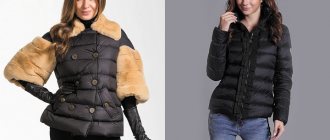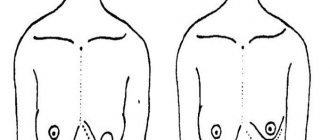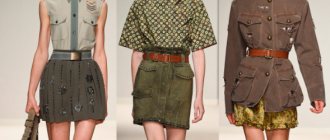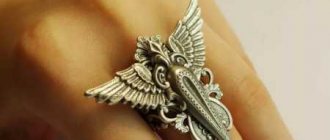Wide ankle boots
The nightmare of any stylist-image maker! The ankle boots end at the widest point of the leg, and they look as if someone had been wearing them for years. They look very unkempt and don't flatter your figure at all.
What to replace: ankle boots-socks. They do not “cut” the leg, but become its continuation, which looks as impressive as possible. The combination of elegant shoes with loose or flared jeans from the knee will be especially advantageous.
Where to find: Stuart Weitzman, Karl Lagerfeld, H&M
Dark round toe ankle boots
Dark shoes with a round toe have a significant drawback that should not be ignored: they land and visually shorten the legs. And it doesn’t matter whether the model has a heel or not.
What to replace: lace-up ankle boots. Lacing stretches the look vertically, visually adding a few centimeters to the length of the legs. If we want to achieve a wow effect, then we put on a miniskirt and rely on a pointed model in a nude shade.
Where to find: Saint Laurent, BY FAR, Zara
When is a rollback possible in practice?
Everyone who tries to work on developing the body notices that after visible progress there comes a setback. It may seem that everything, now this pose has been completely mastered. It is performed easily and naturally, but the next day the body stiffens and discomfort is felt in the pose again. If you focus on working on problem areas only when working on asanas, then even mental problems may appear. It is better, through your own practice, to build harmonious complexes that include all types of poses.
It is very important to learn to focus not on results. Since the desire to achieve some result leads to stress, trauma and mental problems. You need to accept yourself as you are today and practice asanas every time without strain, without looking back at yesterday’s results, without setting yourself any extra tasks.
There is no point in reaching the limits of the musculoskeletal system. A great gymnast is not a yogi. If you are able to sit for a long time (about 1 hour) in a meditative position with a straight back, then you need to gradually move on to working with breathing, to Pranayama. Of course, even at this stage of development, asanas are very important for keeping the body in good shape, but there is no need to perform them with manic determination.
It is important, when performing asanas, not to strive for some visible result, but to learn to draw attention inward, concentrate on sensations in the body, on breathing, and then the practice of asanas will begin to smoothly develop into the practice of Pranayama and Meditation. Otherwise, you can get carried away with acrobatics to such an extent that the essence of the practice is lost - Self-knowledge, Self-improvement, Self-realization.
Each person has their own sensations in asana. People simply cannot have the same sensations in the same poses due to different body proportions and general physical fitness. For some, one part of the body will turn on more strongly, for others, another. It is important that the instructor understands that one cannot rely only on his own personal experience.
Sandals with thick straps
Sandals with wide straps either pinch the foot or dangle loosely (if the size is large). The result: your legs appear wider than they actually are. The rule also applies to short models of sandals and high gladiators.
What to replace it with: a model with ties. A pair will emphasize the fragility of our legs and will elegantly fit into a romantic image. Getting ready to receive compliments!
Where to find: Bottega Veneta, Katy Perry, Asos
To judge the correctness of a child’s development, assessing the proportions of a child’s body is of great importance. Individual parts of a child’s body grow unevenly, and therefore, the relationships between them change with age: for example, over the entire period of growth, the length of the lower limbs increases approximately 5 times, the length of the upper limbs increases by 4 times, the torso increases by 3 times, and the height of the head - only 2 times.
Percentages are percentages. The percentile is called the short-lived body size above the large or tall percentile. Different parts of the body tend to grow in proportion to each other. However, this trend is not very pronounced. For this reason, body proportions change significantly during childhood. The long bones are still relatively short, so the head and torso are especially large in infants and toddlers. Later, limbs grow faster, and in adolescence, teenagers look very lanky.
While in early childhood the length-to-length ratio is more clearly above 0, i.e. the head and torso are much longer than the legs, this value is canceled during puberty; now the legs are longer than the head and torso. Towards the end of the growth phase, this factor returns to normal, first with growth of the fingers and toes, then the forearms and lower extremities, and finally the upper shoulders and hips. The body is still growing into early adulthood. For this reason, adults have a slightly higher ratio of upper to lower length than young adults.
A visual representation of the age-related characteristics of the proportions of a child’s body is given in Fig. 1, although it is compiled somewhat schematically and therefore not perfectly accurate.
Rice. 1. Proportions of a child’s body at different ages
The height of the head in a newborn is approximately 1/4 of the total body length, in a 2-year-old child - 1/5, in a 6-year-old - 1/6, in a 12-year-old - 1/7 and, finally, in an adult - 1/8 .
Estimated final size is the baby's expected final size based on bone age. The size of the target, which can be calculated from the parent variables, can be distinguished. Thus, the estimated final size can be derived from the current body size and bone age. General methods for determining the age of bones are derived from Greulich and Pyle, with the tables of Bailey and Pinnot, Tanner, Whitehouse and others, and Roche, Weiner and Essen.
The secular trend is the tendency to increase height and increase body weight. The trend was already noticed at the end of the century and described in detail in detail. The secular trend is usually associated with accelerated development of childhood and puberty. The model is not without controversy. Our own group views growth as a sequence of short, so-called miniature growth pulses, occurring at intervals of several days and interspersed with periods of approximately linear long-term growth, especially in premature infants.
The head circumference at birth is on average 35 cm; it increases especially intensively during the first months of life, by the end of the year it reaches 46 cm, by 6 years - 50.5-51 cm, and in all subsequent years it increases only by 5-6 cm. In girls, the head circumference is slightly smaller than in boys.
The fetus and partly the newborn are characterized by some relative underdevelopment of the facial part of the skull compared to the well-developed cranial part (Fig. 2). A clearly prominent frontonasal ridge and some underdevelopment of the lower jaw are characteristic of the face of a newborn.
We find miniature growth impulses very similar to rabbits, rats and human infants and premature babies. Miniature growth rods were discovered using precise transverse length measurements. Skeletal age: cat age. Body size, weight and many other dimensions can be specified absolutely, i.e. in centimeters, kilograms or other units. However, they can also be relative, i.e. in relation to something. If the child's body size is relative, i.e. in relation to the parents' body size, no one knows how big the child is absolute, that is, in centimeters, however, it is known how big the child is compared to a comparable one, i.e. normal sized children.
Rice. 2. Skull configuration at different ages
To characterize the physical development of a child, a correct assessment of the characteristics of his chest is of great importance. The chest circumference of a newborn is on average 33-35 cm; it grows rapidly during the 1st year of life, increases more or less evenly in early and preschool age, and during puberty the intensity of the increase in chest circumference again noticeably increases. By the end of the 1st year of life, the chest circumference reaches approximately 48 cm, by 5 years - 55 cm, by 10 years - 63 and by 14-15 years - 75-78 cm. The chest circumference of boys of all ages is larger than that of girls, and only in puberty do boys lag behind girls in this regard.
The normal range for body size is determined by the mean and standard deviation. Seat height is the height of the person sitting minus the height of the seat. Seat height includes barrel length plus neck length and head height. Comparing seat height with body size allows one to estimate the relative length of the trunk and legs. Sitting height is greatest at birth and lowest during mid-puberty.
Another way to determine the relative length of the fuselage and legs is to measure the damping coefficient of the top length. In this case, the palpable superior edge of the symphysis serves as a separation between the superior and inferior lengths. A stadiometer is an instrument for measuring body height. The measurement accuracy is about plus or minus 2 millimeters under optimal conditions and well-trained personnel. Measurements with other, simpler devices or even on the inside door frame are less accurate and have an error of at least plus or minus 4-5 millimeters.
The anterior-posterior dimension of the chest in most full-term newborns is less than or equal to the transverse diameter; already during the 1st year of life, even in children weak at birth, the transverse diameter begins to prevail over the anteroposterior: the first doubles by the age of 6, the second - only by 14-15 years.
In a newborn, the chest circumference exceeds half height by 8-10 cm, by 2-2.5 years this difference (Erisman index) reaches 12-13 cm, then begins to decrease, and at the age of 6-8 years or slightly later the chest circumference is equal to half the length bodies. In the prepubertal period and in the first years of puberty, the chest circumference lags several centimeters behind half-height, and after the end of puberty it again dominates it. The better the child is physically developed, the later his chest circumference becomes equal to half height and the sooner it begins to prevail over him again.
The period of no growth activity between 2 salts. Children usually grow relatively constant in relation to their age peers; Children who are small compared to their peers tend to stay small, while large children tend to stay big. Therefore, children tend to remain at their percentiles for body height, thereby maintaining their growth channel. However, recent research shows that this so-called growth channeling is not very strict and can lead to large deviations at all ages.
In a full-term newborn baby, the chest circumference is 2-4 cm less than the head circumference. In very strong newborns, they are equal, and relatively very rarely the chest circumference exceeds the head circumference. Already during the first half of the 1st year of life, the head circumference is compared with the chest circumference, and in subsequent years the chest circumference exceeds the head circumference by approximately as many centimeters as the child’s age.
For this reason, it is better to talk about growth roads than growth channels. The idea of growth paths is more flexible and better illustrates the different possibilities that individual growth can have. A child's growth curve is usually understood as the individual progression of his body size, taking into account the progression of his age-related peers.
The increase in body size per unit time is called height or growth rate. The growth rate is usually expressed in centimeters per year. It is tallest shortly after birth and is approximately 25 cm in the first year of life. It then drops to 6 cm in the year before puberty and rises again during puberty.
The length of the body is relatively large in newborns (about 45% of body length), then its relative size gradually decreases until puberty (about 38% of body length) and again increases slightly towards the end of it, which is explained by the earlier end of limb growth.
Sitting height in newborns is about 34 cm, by the end of the 1st year of life - about 47 cm, by 6 years it reaches approximately 60 cm, by 10 years - 70 cm and by 15 years - 82-84 cm.
Individually, growth rates fluctuate significantly. In addition to the short-term changes in mini growth, there are also a number of growth spurts that occur at intervals of about 2 years. Children often complain during kindergarten or school age that their legs hurt at night. The pain is indicated alternately to the left or to the right, usually in the area of the large joints of the epiphysis of the knee. As children of this age grow, these uncharacteristic complaints are simply called growing pains. There is no doubt that the complaints are related to growth.
However, since we know that the body expands at night during the circular circadian rhythm and can grow at rates of up to 0.2 millimeters per hour during mini-growth spurts, it should not be surprising that children experience discomfort when the cartilage tissue of the epiphyseal gap.
Abdominal circumference is an individually extremely variable value, and its absolute dimensions characterize relatively little the morphological characteristics of the child. In children without pathological phenomena from the chest and abdominal cavity, the abdominal circumference should be slightly less than the chest circumference. Diet, routine, muscle tone, rickets, etc. are of great importance for the size of the abdomen.
Growing pains are always a diagnosis of exclusion. Only if all other causes of pain are excluded can we talk about growing pains. Therefore, it is necessary to be absolutely sure that bone inflammation, rheumatic diseases and tumors are excluded as the cause of night pain in the legs.
Growing pains can be greatly relieved by paracetamol or ibuprofen, but sometimes the psychology of a mother's hand or a heat pad is sufficient. Target size is the expected final size of the child calculated from the parent variables. According to Tanner, target size is calculated as follows.
To assess the uniqueness of the morphological characteristics of a child’s body, knowledge of the age-related characteristics of growth of the upper and lower extremities is of great importance. The length of the legs and arms of a newborn slightly exceeds 1/3 of the body length, while in adults the length of the legs is approximately equal to 1/2 of the height, and the length of the arms is about 45% of the body length. Children's limbs grow faster than their torso, but their growth ends somewhat earlier. From this it is clear (see Fig. 1) that the child is short-legged, and this is more pronounced the younger he is.
Body height is about an inch and a half greater in the morning than in the evening. Since growth hormone is primarily distributed at night, it is often premature to conclude that a child's growth—in terms of cell division—occurs primarily at night. However, children often experience leg discomfort that occurs at night in the area of the large growth joints, called growing pains.
Feet play a vital role in life
"You can't stand on one leg." Whether walking, strolling, jogging, jogging or bouncing, our feet allow us to enjoy a wide variety of gaits. Did you really know that our legs carry us a whole thousand kilometers in one life?! - That's about three times on the ground. For what two stilts are still good, you can find out here.
As a result of uneven growth of the head, torso and limbs, the midpoint of the body length moves. In an embryo of an early period of development, this point is located at the chin, in a premature baby - above the navel, in a full-term newborn - almost at the navel, and then, gradually falling below the navel, at the age of about 6 years it is already in the middle between the navel and the symphysis, and in adult - on the symphysis.
Our legs are full of the chords of the body: they contain our largest bone, largest joint and largest muscle. Why we run on only two legs and not four is still not entirely clear. The fact is that man is the only living creature that moves exclusively on two legs.
Our legs make up almost half of our weight. Not surprising, because they must withstand enormous forces. The largest and at the same time the thickest bone in a person is located in the legs - the thigh bones. In an adult it is about half a meter.
In children of early and preschool age, there is a constant relationship between the perimeters of the limbs and the chest: triple the circumference of the shoulder is equal to the circumference of the chest; the sum of the circumferences of the thigh and lower leg is equal to triple the circumference of the shoulder and the circumference of the chest. The presence of these ratios indicates the child’s normal fatness and the correct development of his muscular system.
To keep us from leaning while walking, the knee stabilized us. There is not only the largest but also the most stressed joint in the human body. Therefore, it is especially vulnerable to injury. A quarter of all sports injuries are caused by knee problems. Despite all the sensitivity, our knee does hard work: it can withstand pressure of 1.5 tons. The ischalis muscle is also extremely durable. When walking, a trinity of our body weight affects it. And when we jump, even up to ten times.
Our feet still have a record: the strength of our Achilles tendons. It is the longest and strongest human chain with more than 20 centimeters. It holds up to 800 kilograms. The leg ends at the hips, think most of all. The buttock belongs anatomically to the leg. And his image is extremely ambivalent. On the one hand, it acts as an erotic signal about women and men. Whether it's crunchy, angular or round, it's mostly comfortable for us to sit on. For this reason, the pomusque is the largest muscle in the body.
Instructions
In order to measure the length of your legs accurately and correctly, ask someone close to you to help you. Stand up straight, distributing your body weight evenly on both legs. Try to keep your back straight. Of course, the position of the body will not have much influence on the measurement result, but it can “steal” a couple of centimeters.
In the end, however, he is, above all, a true spectacle - for her and for him. Well selected and well trained, the butt is a real spectacle - men especially love to court women with a good butt. Women love to help with high heels. But lies often have short legs.
The leg is not equal to the leg: short, thick, thin and long. At a total of 132 centimeters, Russian Svetlana Pankratova has the longest legs in the world, literally legs on her neck. Good for her, you have to think: people with long legs returned to a certain speed faster than people with short legs. If you have long legs, you take more but fewer steps. For short legs it's exactly the opposite. The point is that they both have a small distance.
Have your assistant use a measuring tape to measure your leg length. According to the rules, the length of the legs is measured from the protruding tubercle of the femur, located opposite the hip joint, to the heel strictly vertically. To ensure the objectivity of the result obtained, you can measure the length of both legs.
But how quickly do we even leave? About five kilometers per hour. When we run, we double up. Usain Bolt, the fastest man in the world, runs up to 38 kilometers per hour. How fast we walk, by the way, depends on where we live. Walking speed decreases in Germany from north to south. They are half a kilometer less per hour than their northern counterparts.
Do you think that man only had two legs? Cheek, collarbone, calf bone—that all these bones carry the leg in their name has a very simple reason: “leg” meant nothing more than “bone.” For women, the average leg length is 103 centimeters. Interestingly, this is an inch less for men - although men are ten centimeters larger than women.
Women usually like to compare themselves to various beauty ideals. Compare the measurements obtained with information on the ratio of height and leg length:
Video on the topic
Sources:
- How to measure distance
Body weight
is
a physical quantity that characterizes the degree of influence of a given
body on
the support.
Like any force in physics, the weight of a body
is measured in Newtons (N).
Measuring body
is very easy.
Instructions
Suppose we are given a body that has a mass m, which lies motionless on some support, or is in a suspended state, acting on this support. Then, knowing the magnitude of the acceleration due to gravity (this value is constant on our planet, equal to 9.81 m/s²), you can find the weight of the body
, using the following formula: P = m*g
In the event that the body is in a mobile state, moving tangentially to the inertial reference system, its weight can be found using the formula: P = m*(g+a), where a is the acceleration of the given body
, measured in m/s²
To make it clearer, you can consider a couple of examples: Example 1: Body
lying on a support is 15 kg, you need to find the weight of this
body
.
To solve this problem, you will need to use the very first formula, which was indicated above: P = 15 * 9.81 = 147.15 N Answer: the weight of this body
147.15 N Example 2: The mass
of a body
that moves relative to the inertial reference system is 12 kg, the acceleration of this
body
5 m/s² In this case, to solve the problem of finding the weight
of a body
, you will need to use the second formula: P = 12*(9.81 + 5) = 177.72 N Answer: the weight of this
body
is 177.72 N
note
In no case should one confuse such seemingly similar physical quantities as weight and mass. Weight is the force with which the body acts on a support. Mass is the magnitude of the gravitational influence of a body on the point of application of a given mass. It’s even worth recalling an elementary example: the weight of any body in weightlessness (the state of weightlessness is achieved by eliminating the gravitational influence of the Earth) is zero. But at the same time, it is no secret to anyone that any of the bodies has its own mass. Gravity acceleration is another physical quantity, which is the acceleration imparted to a body by the force of gravity, and this force acts on the body in a vacuum.
Related article
Most often, a person's height is determined by heredity. However, factors such as proper nutrition and exercise can influence this value. How to correctly measure your height at home?
Ballet flats with thin soles
Style experts are convinced that ballet flats are not for everyone. Perhaps only tall young ladies with long and very slender legs can wear them without compromising their image.
What to replace: ballet flats with small wide heels (up to 7 centimeters). Firstly, it is more physiological (orthopedists recommend giving up flat soles), and secondly, they do not hide the length of the legs.
Where to find: Salvatore Ferragamo, Hogl, Caprice
High boots visually lengthen your legs
The visual effect of long legs is created not only by over the knee boots, but mainly by boots slightly above average length. High classic and knee-length boots, the color of which is identical to the color of the skirt, are welcome. Learn to combine these two wardrobe elements correctly and forget about your problem forever.
https://www.instagram.com/zara__europe/










